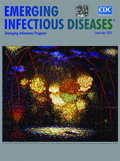About EIP

The September 2015 issue of the Emerging Infectious DiseasesCdc-pdf
The Emerging Infections Program (EIP) was established in 1995 in response to the Centers for Disease Control and Prevention’s (CDC) 1994 strategy, Addressing Emerging Infectious Disease Threats: A Prevention Strategy for the United States Cdc-pdf
EIP is a network of 10 state health departments (California, Colorado, Connecticut, Georgia, Maryland, Minnesota, New Mexico, New York, Oregon and Tennessee) and their collaboration with academic institutions, federal agencies, public health and clinical laboratories, infection preventionists, and healthcare providers. The EIP population is roughly representative of the U.S. population on the basis of demographic characteristics such as age, gender, race, and urban residence, as well as health indicators such as population density and percent at or below the poverty level.
The EIP network is a national resource for surveillance, prevention, and the control of emerging infectious diseases. go beyond routine functions of health departments by:
- Addressing important issues in infectious diseases and selecting projects the EIP network is particularly suited to investigate,
- maintaining sufficient flexibility for emergency response and addressing new problems as they arise,
- developing and evaluating public health interventions and transferring lessons learned to public health agencies,
- incorporating training as a key function of EIP activities, and
- giving high priority to projects that lead directly to the prevention of disease.
EIP’s Impact
The EIP network’s unique strength and contribution lies in its ability to quickly translate surveillance and research activities into informed policy and public health practice. For example, EIP work has been instrumental in the nation’s post-licensure evaluation of the 7-valent pneumococcal conjugate vaccine, evaluating and honing strategies for preventing severe disease in newborns caused by Group B Streptococcus, developing methodology to estimate ranges of 2009 H1N1 influenza cases and related hospitalization and deaths, and defining the rapidly changing epidemiology and growing burden of MRSA. The network has generated more than 510 publications with data obtained from core EIP activities, Active Bacterial Core surveillance (ABCs), FoodNet, Influenza projects, and Healthcare Associated Infections – Community Interface projects, as well as other special studies.